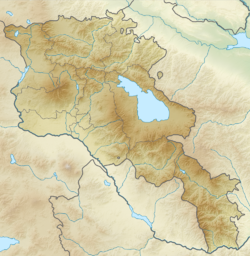Top Qs
Timeline
Chat
Perspective
Hartashen Megalithic Avenue
Megalith site in Armenia From Wikipedia, the free encyclopedia
Remove ads
Hartashen Megalithic Avenue is a megalithic monument in Armenia. There are two avenues of megalithic rocks which do not intersect.[1] These avenues are composed of basalt stones which are placed at an angle, and menhirs are arranged in three rows in each.[2] The purpose of these three rows of menhirs in unclear and further research is underway.[3] There is no firm dating of the monument. It has been attributed in recent years to anti-tank defences constructed in the Second World War, but recent research favours an interpretation that the site, if not its arrangement, dates to the Neolithic or Bronze Age and perhaps shares a context with the Carnac stones of France.[4]
Remove ads
Context
The monument comprises 760 preserved steles. Some steles have been disturbed, and it is estimated there may have been up to 1,200 originally. The flat surface between the monuments comprises an unexcavated funerary monument. No connection has been discovered between the avenue and the funerary monuments. The rows of stele begin at a rocky outcrop and follow the valley topography for 500 metres (1,600 ft). The monument is not astronomically aligned, nor aligned with any features within the topography.[4]
The arrangement of the stone rows were integrated into a modern anti-tank military barrier. As there is no firm dating, it is unknown to what extent and in what form the avenues predate this modern use.[5]
Remove ads
See also
- Carahunge
- Desert kite
- Funzie Girt, an ancient dividing wall that runs for over 4 km (2.5 mi) across the island of Fetlar in Scotland.
References
Bibliography
Wikiwand - on
Seamless Wikipedia browsing. On steroids.
Remove ads
